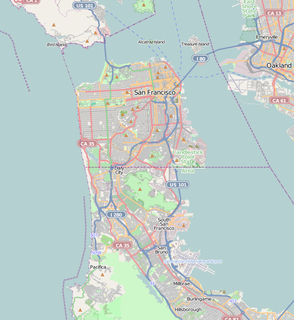
The San Francisco Maritime National Historical Park is located in San Francisco, California, United States. The park includes a fleet of historic vessels, a visitor center, a maritime museum, and a library/research facility. The park used to be referred to as the San Francisco Maritime Museum, however the former 1951 name changed in 1978 when the collections were acquired by the National Park Service. Today's San Francisco Maritime National Historical Park was authorized in 1988; the maritime museum is among the park's many cultural resources. The park also incorporates the Aquatic Park Historic District, bounded by Van Ness Avenue, Polk Street, and Hyde Street.
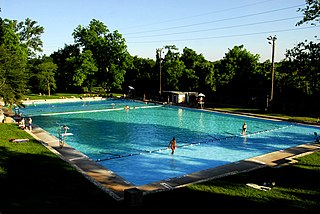
Deep Eddy Pool is a historic, man-made swimming pool in Austin, Texas. Deep Eddy is the oldest swimming pool in Texas and features a bathhouse built during the Depression era by the Works Progress Administration. The pool began as a swimming hole in the Colorado River, became a resort in the 1920s, and is today a popular swimming pool operated by the City of Austin.

Aquatic Park Historic District is a National Historic Landmark and building complex located on the San Francisco Bay waterfront within San Francisco Maritime National Historical Park.
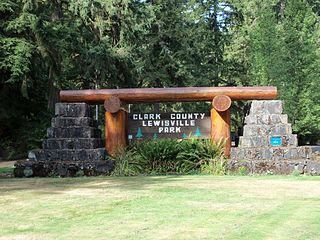
Lewisville Park is a 154-acre regional park located two miles north of Battle Ground in Clark County, Washington. It was listed on the National Register of Historic Places in 1986.

Glen Park Municipal Swimming Pool is a historic swimming pool in River Falls, Wisconsin. The complex includes a pool and two American Craftsman Style buildings. The pool was built as a Civil Works Administration project during the Great Depression. Work on the pool began in 1933-34 and continued through 1937 with additional support from the Public Works Administration and Works Progress Administration. Engineer Herman T. Hagestad, who would later become city engineer and ultimately mayor of River Falls, designed the pool. The pool was added to the National Register of Historic Places in 2007 and is still operational.

The Fowler Swimming Pool and Bathhouse, located at 308 E. 6th in Fowler, Kansas, was built in 1936 by the Works Progress Administration, a New Deal work program. It includes an oval pool and a bathhouse designed in Moderne style architecture. It was listed on the National Register of Historic Places in 2009. The listing included the pool and bathhouse as contributing elements and a restroom building as a non-contributing building.

The Hugo Municipal Pool, in Hugo, Colorado, was built during 1936-38. It is located at the junction of US 287 and 6th Ave. Its building was designed by Lloyd E. Heggenberger and built by the Works Progress Administration in what has come to be known as WPA Moderne style. It was listed on the National Register of Historic Places in 2008.

Burlington Community Swimming Pools and Bathhouse in Burlington, Wisconsin, is a historic property that was listed on the National Register of Historic Places on October 23, 2013.
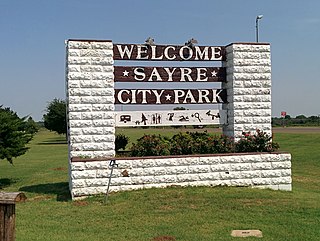
The Sayre City Park is a public park located along historic U.S. Route 66 on the south end of Sayre, Oklahoma. The park formally opened in 1940; however, the land had been owned by the city and used informally as a park for several years prior. The Works Progress Administration built the park's structures according to plans designed by J.N. Willis. The park's bathhouse and swimming pool, the dominant features of the park, have a Pueblo Revival design with ornamental vigas. Other park features include a miniature golf course, a gazebo, and tennis courts. The park attracted both locals and travelers on Route 66, who regularly camped in the park. A local business district also developed around the park, primarily to serve tourists.

The Beach Club is a private oceanfront club at 2450 Ocean Boulevard in Rye, New Hampshire. Founded in 1925, it is the only beachfront private club to survive from the early 20th century along New Hampshire's coast. It was listed on the National Register of Historic Places in 2013.

The Pawnee Armory in Pawnee County, Oklahoma, United States, is a single story rectangular building measuring 149 ft (45 m) x 237 ft (72 m). It was built of native stone by the Works Progress Administration. According to the plaque on the building it was completed in 1936, though the application form for the National Historic Places Registration form indicates it was finished in 1937. It originally housed the Oklahoma National Guard. It was added to the National Register of Historic Places in 1994.

The El Reno Municipal Swimming Pool Bath House is a bath house in El Reno, Oklahoma. Built in 1935, it was listed on the National Register of Historic Places in 2000. It is one of two Mission/Spanish Revival structures in El Reno.

The Spring Lake Recreation Area is a recreational facility of the Ozark-St. Francis National Forest in Yell County, Arkansas. It is located north of Danville, in and around Spring Lake, a man-made lake constructed in 1937 with funding from the Works Progress Administration. The area has facilities for fishing and picnicking, including many structures built with WPA funding the Rustic style common to work of the Civilian Conservation Corps. Facilities from that period include picnic pavilions and developed picnic sites, a bathhouse, two swimming platforms, the Spring Lake Bridge, and the dam which impounds Spring Creek at the southern end of the lake. The area was listed on the National Register of Historic Places in 1995 as the Spring Lake Recreation Area Historic District.

Lacey-Keosauqua State Park is located southwest of Keosauqua, Iowa, United States. Located along the Des Moines River in Van Buren County, it was dedicated in 1921. It is the largest state park in size in Iowa. In 1990 three areas were named nationally recognized historic districts and listed on the National Register of Historic Places.

The Cove Lake Bathhouse is a historic recreational facility at the Cove Lake Recreation Area, north of Corley, Arkansas in the Ozark-St. Francis National Forest. It is a T-shaped stone structure, built of fieldstone with a gabled roof. A porch extends across the front, supported by stone piers. The roof is pierced by three triangular dormers with vents in them. It was built in 1937 with funding from the Works Progress Administration, and represents a distinctive departure from the more typical Rustic architecture produced by WPA projects.

The Decorah Municipal Bathhouse and Swimming Pool is located in Decorah, Iowa, United States. Edward Novak of the Charles Altfillisch architectural firm in Decorah designed the facility in the Art Moderne and the International Style. The project was a partnership between the local government and the federal Works Progress Administration (WPA). The property on which it stands was donated by Luther College and a few local citizens. The Fred Carlson Company of Decorah, which supervised its construction, hired unemployed men from the area as laborers. The bathhouse "is the only remaining building from WPA projects of its style and significance in Iowa." It was listed on the National Register of Historic Places in 2012.

Knoxville WPA Athletic Field Historic District is a nationally recognized historic district located in Knoxville, Iowa, United States. It was listed on the National Register of Historic Places in 2007. At the time of its nomination the district consisted of 14 resources, including three contributing buildings, seven contributing structures, one contributing site, two noncontributing buildings, and one noncontributing structure. The oldest structure in the district is the city-owned water tower that was completed in 1922 on what was the city reservoir. Two Works Progress Administration (WPA) projects were added in the 1930s.

Fayette City Park Swimming Pool, also known as the Fayette WPA Pool and WWI Memorial, is a historic swimming pool located at Fayette, Howard County, Missouri. It was built in 1936 as a Works Progress Administration funded project. The pool building is a roughly egg shaped, one-story Art Deco structure with a rectangular two-story entrance hall on the north. The building has two-toned brick walls and a concrete foundation.
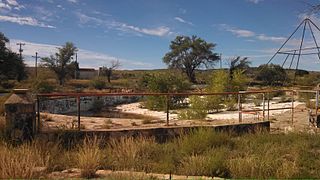
The Metropolitan Park Bathhouse and Pool Historic District, in Tucumcari in Quay County, New Mexico, was listed on the National Register of Historic Places in 1996. The listing includes one contributing building, a contributing structure, and a contributing site.

The Holton Bath House is a bathhouse in Holton in Jackson County, Kansas which was built in 1938 as a WPA project. It was listed on the National Register of Historic Places in 2009.


























